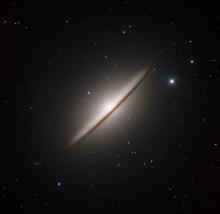Listen to today's episode of StarDate on the web the same day it airs in high-quality streaming audio without any extra ads or announcements. Choose a $8 one-month pass, or listen every day for a year for just $30.
You are here
Trimming Down
A pair of supermassive black holes may have trimmed down a bit. The black holes themselves didn’t change — only our understanding of them.
Together, the pair is known as OJ 287. It was the first supermassive black hole binary ever confirmed.
Through decades of observation, astronomers pieced together a model of the system. The dominant member of the pair was more than 18 billion times the mass of the Sun — one of the largest black holes yet seen. Its companion was only about one percent as massive, but still a beast.
OJ 287 has produced a pair of bright eruptions every 12 years or so. That was interpreted as the smaller black hole plunging through a disk of hot gas around the larger one, creating some brilliant fireworks. But an eruption that was expected late last year was months late.
A team kept an eye on the system for six years. The astronomers used several telescopes on the ground and in space, covering everything from radio waves to X-rays. That allowed them to measure the mass of the disk of hot gas. It turned out to be a lot lower than expected. That means the main black hole has to be less massive than expected as well — about a hundred million times the Sun’s mass. That’s still a monster, but one that’s a lot trimmer than expected.
OJ 287 is about five billion light-years away, in Cancer, the crab. The constellation is high in the southeast at first light.
Script by Damond Benningfield





